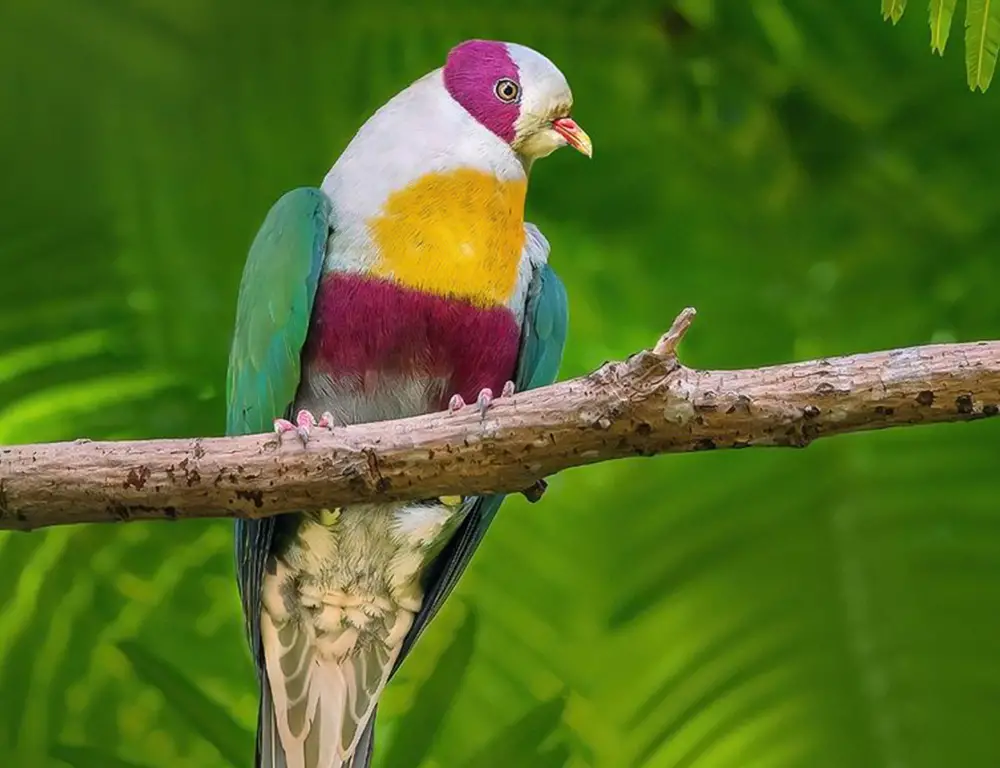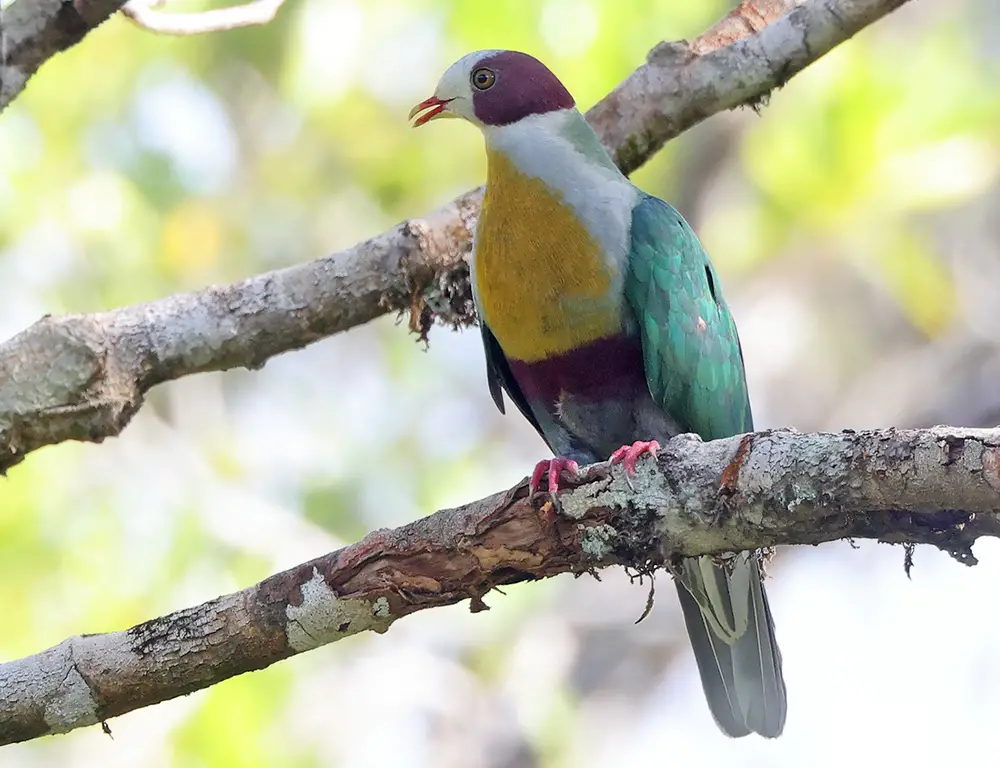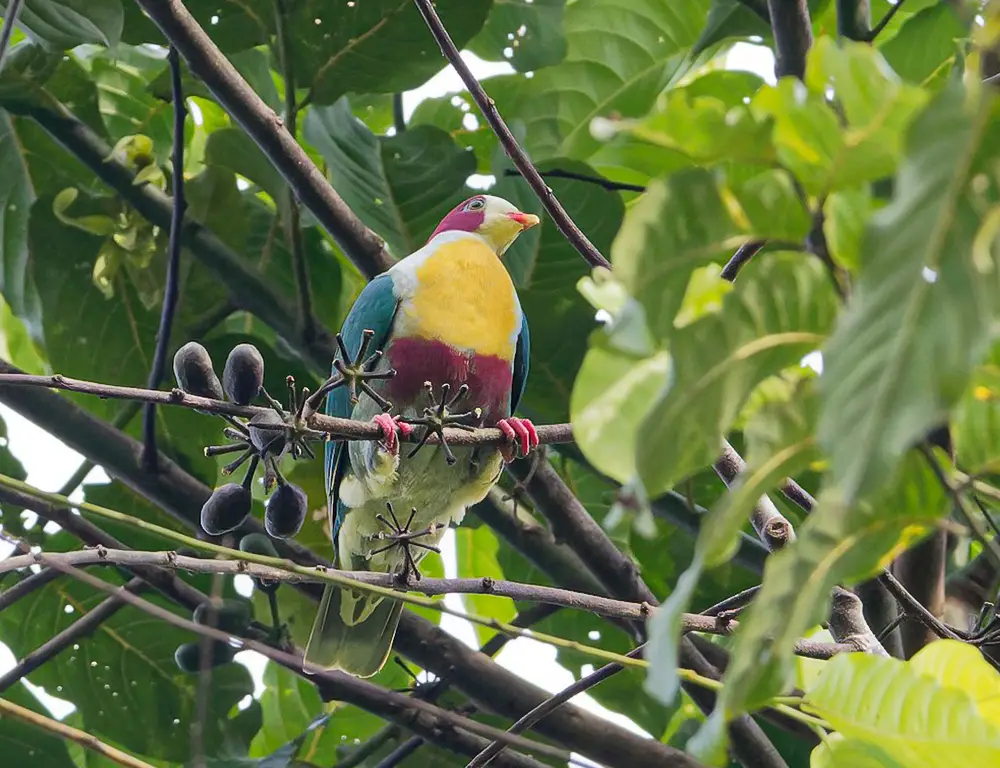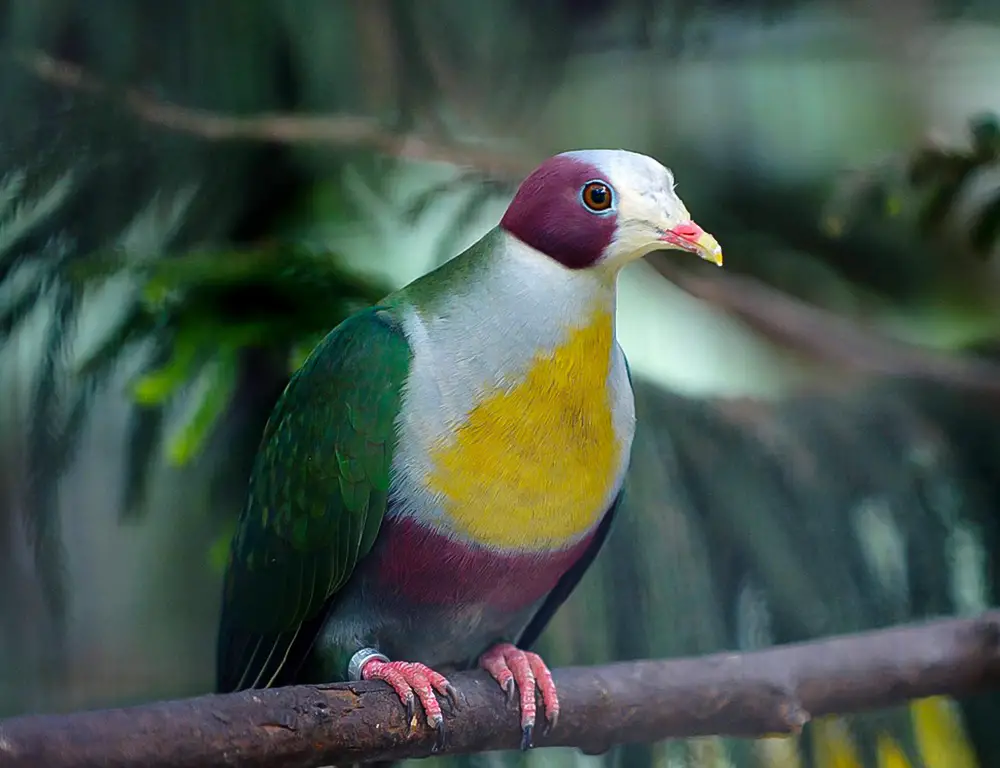In the rich tapestry of avian wildlife, one species stands out with its captivating presence: the Yellow-Breasted Fruit Dove.
Native to the lush islands of Southeast Asia, this remarkable bird, scientifically known as Ptilinopus occipitalis, boasts a striking yellow breast that contrasts vividly with its green plumage.
Beyond its eye-catching appearance, the unique lifestyle and habits of the Yellow-Breasted Fruit Dove intrigue me. From its frugivorous diet to its intricate mating rituals, there are fascinating aspects to explore.
Join me on a journey to unravel the mysteries of this enchanting species and discover the wonders within the vibrant world of the Yellow-Breasted Fruit Dove.

Physical Characteristics of the Yellow-Breasted Fruit Dove
The Yellow-Breasted Fruit Dove (Ptilinopus occipitalis) is known for its distinctive physical characteristics, contributing to its vibrant appearance and ecological role.
Here are the key physical traits of this species:
Coloration
The most striking feature of the Yellow-Breasted Fruit Dove is its vibrant plumage. As the name suggests, it has a bright yellow breast, contrasting sharply with the predominantly green plumage covering its body.
The back and wings of the bird are usually adorned with shades of green, providing excellent camouflage in its forest habitat.
They typically have a purple cap on their heads, adding to their colorful appearance.
Size
Yellow-Breasted Fruit Doves are relatively small birds, measuring around 23-25 centimeters (9-10 inches) in length on average. While they are more significant than other small bird species, they are still considered small compared to many different bird species.
Beak
Their beaks are tiny yet sturdy, adapted for their frugivorous diet. They are capable of handling a variety of soft fruits found in their forest habitat.
Their beaks are considered “generalist,” allowing them to consume a wide range of fruit types rather than being specialized for specific foods.
Eyes
Their eyes are particularly noteworthy due to their vibrant red, which stands out against the surrounding plumage. The eyes are encircled by a thin blue ring, adding to the bird’s striking appearance.
Sexual Dimorphism
Males and females may exhibit plumage coloration or marking differences in many bird species.
While Yellow-Breasted Fruit Doves generally do not exhibit significant sexual dimorphism, males may sometimes have slightly brighter or more colorful plumage than females, particularly during the breeding season.
Habitat and Distribution of the Yellow-Breasted Fruit Dove

The Yellow-Breasted Fruit Dove (Ptilinopus occipitalis) is native to various parts of Southeast Asia and is primarily found in countries such as Indonesia and the Philippines.
Here’s a closer look at its habitat and distribution:
Habitat Preferences
Yellow-Breasted Fruit Doves typically inhabit subtropical or tropical moist lowland forests. Within these forests, they are commonly found in areas with dense vegetation and abundant fruit-bearing trees.
They prefer mountainous regions and are often observed at elevations ranging from sea level up to 1,400 meters (4,600 feet). These habitats provide them with ample shelter, nesting sites, and a diverse array of food sources.
Forest Habitats
The Yellow-Breasted Fruit Dove thrives in diverse forest ecosystems, including primary and secondary forests. They are also known to inhabit plantations, although they prefer natural forest environments.
These birds are particularly attracted to areas with a rich variety of fruit-bearing trees, which serve as their primary food source.
Geographic Range
While endemic to the Philippines, Yellow-Breasted Fruit Doves can be found across various islands in the region, including Luzon, Mindanao, Leyte, and Samar. However, they are not limited to the Philippines and may also occur in other parts of Southeast Asia.
Despite their broad geographic range, they are still considered a Near Threatened species due to habitat loss caused by deforestation and other human activities.
The behavior of the Yellow-Breasted Fruit Dove

The behavior of the Yellow-Breasted Fruit Dove (Ptilinopus occipitalis) is characterized by its feeding habits, breeding behavior, and social interactions.
Here’s an overview of their behavior:
Diet
Yellow-Breasted Fruit Doves are primarily frugivorous, meaning they mainly feed on fruits. They have a diverse diet that includes a variety of fruits found in their forest habitats. These fruits may consist of figs, berries, and small fruits from forest trees.
The abundance of fruit in their environment provides them a reliable food source throughout the year. They are known to forage for fruits individually and in small groups, often moving from tree to tree in search of ripe fruits.
Feeding Behavior
Yellow-Breasted Fruit Doves use their specialized beaks to handle soft fruits when feeding. They may pluck fruits from trees or pick them up from the forest floor.
After consuming the fruit’s pulp, they may regurgitate seeds, contributing to seed dispersal within the ecosystem. This behavior plays a crucial role in maintaining forest biodiversity and ecosystem health.
Breeding
Yellow-Breasted Fruit Doves typically form monogamous pairs during the breeding season. Male doves engage in elaborate courtship displays to attract mates, including vocalizations, wing displays, and other behaviors.
Once a pair bond is formed, the male and female build a nest on horizontal branches or vines concealed by foliage. The female typically lays only one egg per clutch, and both parents share incubation duties until the egg hatches.
After hatching, the parents care for the young bird, providing it with food until it leaves the nest.
Social Behavior
While Yellow-Breasted Fruit Doves may forage in small groups, they are generally not highly social birds. They tend to maintain small territories within their forest habitat and may interact with neighboring individuals during feeding or breeding activities.
However, they are not known for forming large flocks or engaging in complex social behaviors like other bird species.
Conservation Status of the Yellow-Breasted Fruit Dove

The conservation status of the Yellow-Breasted Fruit Dove (Ptilinopus occipitalis) is currently classified as “Least Concern” by the International Union for Conservation of Nature (IUCN).
However, this designation does not imply that the species is entirely safe or without threats. Here’s a detailed overview of its conservation status:
IUCN Red List Classification
The “Least Concern” classification indicates that the Yellow-Breasted Fruit Dove is not currently facing imminent extinction risks.
However, it is essential to note that this classification does not mean the species is entirely out of danger but rather that its population and habitat conditions do not currently meet the criteria for a higher threat category.
Population Estimates
Population estimates for the Yellow-Breasted Fruit Dove have slightly increased over recent years. However, these figures are only estimates and may not fully capture regional population dynamics or the extent of species’ threats.
The estimated population ranges from 20,000 to 40,000 individuals in 2020, indicating a relatively stable population size.
Here are some figures from recent surveys:
| Year | Estimated Population |
|---|---|
| 2010 | 10,000-20,000 |
| 2015 | 15,000-30,000 |
| 2020 | 20,000-40,000 |
Threats
Despite its “Least Concern” status, the Yellow-Breasted Fruit Dove faces several threats to its long-term survival.
Habitat loss and degradation due to deforestation, urbanization, and agricultural expansion are significant concerns, particularly in its native range in the Philippines.
Additionally, the species may be vulnerable to hunting and trapping for the pet trade, although this threat may not be as significant as habitat loss.
Conservation Efforts
Active conservation efforts have been initiated to preserve forest habitats and protect wildlife from hunting and trade.
Local communities, governmental agencies, and conservation organizations are involved in programs to promote biodiversity conservation and raise awareness about preserving the species and its habitat.
Challenges and Future Outlook
While progress has been made in conservation efforts, much work is still needed to ensure the long-term survival of the Yellow-Breasted Fruit Dove.
Continued habitat protection, sustainable land management practices, and community engagement are crucial for mitigating threats and safeguarding the species’ future.
Conclusion
The Yellow-Breasted Fruit Dove embodies nature’s brilliance, showcasing adaptability and ecological importance.
Their vibrant plumage and frugivorous diet contribute to forest regeneration, highlighting their vital role in pollination and seed dispersal.
Despite their understated presence, they are essential components of biodiversity, underscoring the interconnectedness of all species.
However, habitat loss and human activities threaten their survival. We must prioritize conservation efforts to safeguard these remarkable birds for future generations.
By understanding and protecting the Yellow-Breasted Fruit Dove, we uphold biodiversity and ensure the health of our planet. No matter how inconspicuous, every species is critical in sustaining our ecosystems.
Let us value and conserve these beautiful creatures, recognizing that knowledge is the key to their preservation.